Charred wood texture has been gaining significant attention in the design world, known for its unique appearance and remarkable durability. Originating from the ancient Japanese technique of Shou Sugi Ban, this process involves charring wood to enhance its visual appeal while increasing its resistance to the elements. The striking contrast of deep, dark tones with the natural wood grain makes charred wood an increasingly popular choice for both modern and rustic interior and exterior applications. But beyond its beauty, charred wood offers an abundance of functional benefits, making it a wise choice for those looking for a sustainable, long-lasting material.
The Process of Creating Charred Wood
The art of charring wood dates back to ancient Japan, where it was initially used for preserving wood in the face of harsh weather conditions. By using fire to char the surface of the wood, the wood was made more resistant to rot, pests, and water damage. This technique was not only practical but also resulted in a visually striking, textured surface.
To create charred wood, the wood is first carefully burned using a controlled flame, often using a torch or an open flame. The surface is left to char until it reaches the desired blackened hue. The charred surface is then brushed to remove excess soot, revealing a unique texture where the grain of the wood is accentuated by the contrasting dark tones. The result is a beautiful blend of texture, depth, and natural beauty that makes each piece of charred wood unique.
The Aesthetic Appeal of Charred Wood Texture
One of the most appealing aspects of charred wood is its distinctive, textured finish. The charring process highlights the natural grain of the wood, creating a surface with rich, layered patterns. The deep black color contrasts beautifully with lighter areas, offering a striking visual contrast that is both dramatic and sophisticated.
The texture of charred wood varies depending on the type of wood and the charring technique used, but generally, the surface has a rough, tactile quality that adds warmth and character to any space. This makes it an ideal material for those seeking a balance of modern design with a nod to nature.
Charred wood’s bold appearance can be used in a variety of ways. When used for cladding or siding, it gives buildings a rustic, contemporary look, perfect for both residential homes and commercial spaces. Inside, charred wood can be incorporated into furniture, flooring, and feature walls, adding an organic yet edgy element to the interior design. Its versatile, timeless appeal makes it suitable for any setting, whether it’s a traditional farmhouse or a sleek urban apartment.
The Durability of Charred Wood
Beyond its visual appeal, charred wood is incredibly durable. The charring process serves to protect the wood from the elements, making it more resistant to moisture, rot, and pests. The charred layer acts as a natural barrier, preventing water from penetrating the wood’s surface and preserving its integrity for many years.
Additionally, the high level of durability provided by the charring process makes charred wood an ideal material for outdoor use. It’s often used in outdoor decking, cladding, and fencing, where exposure to the elements can quickly deteriorate traditional wood. Thanks to its resistance to weathering and decay, charred wood maintains its striking appearance and functionality over time.
The texture of charred wood also contributes to its longevity. The rough, textured surface resists scratches and wear, and the charred layer further strengthens the wood against external damage. As a result, charred wood can withstand high-traffic areas and harsh conditions while retaining its aesthetic beauty.
Sustainability and Eco-Friendliness of Charred Wood
In today’s design world, sustainability is an increasingly important factor, and charred wood excels in this area. The Shou Sugi Ban technique is an eco-friendly alternative to chemically treated woods, as it doesn’t rely on harmful preservatives or finishes. By using fire, the process of charring wood naturally enhances its resilience without resorting to synthetic chemicals.
Furthermore, charred wood is often sourced from renewable timber, making it a sustainable choice for those looking to reduce their environmental footprint. Its long-lasting durability reduces the need for frequent replacements, contributing to a more sustainable lifecycle for building materials.
Conclusion
Charred wood texture is more than just a design trend; it’s a timeless, durable, and eco-friendly material that offers both beauty and functionality. Whether used for cladding, flooring, furniture, or feature walls, charred wood’s rich texture and deep black tones bring warmth, sophistication, and a natural edge to any space. With its impressive durability, resistance to the elements, and sustainability, charred wood is a material that will continue to shine in design projects for years to come. Whether for interior or exterior applications, the versatility and unique charm of charred wood make it a standout choice for any modern or rustic design.









